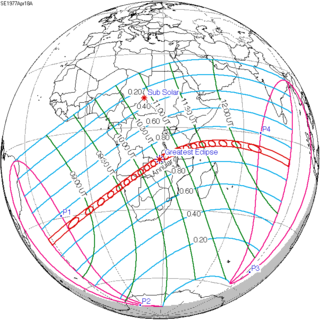Solar eclipse of April 18, 1977
| Solar eclipse of April 18, 1977 | |
|---|---|
| Type of eclipse | |
| Nature | Annular |
| Gamma | −0.399 |
| Magnitude | 0.9449 |
| Maximum eclipse | |
| Duration | 424 s (7 min 4 s) |
| Coordinates | 11°54′S 28°18′E / 11.9°S 28.3°E |
| Max. width of band | 220 km (140 mi) |
| Times (UTC) | |
| Greatest eclipse | 10:31:30 |
| References | |
| Saros | 138 (29 of 70) |
| Catalog # (SE5000) | 9458 |
An annular solar eclipse took place at the Moon's descending node of the orbit on Monday, April 18, 1977. A solar eclipse occurs when the Moon passes between Earth and the Sun, thereby totally or partly obscuring the image of the Sun for a viewer on Earth. An annular solar eclipse occurs when the Moon's apparent diameter is smaller than the Sun's, blocking most of the Sun's light and causing the Sun to look like an annulus (ring). An annular eclipse appears as a partial eclipse over a region of the Earth thousands of kilometres wide. Annularity was visible in South West Africa (today's Namibia), Angola, Zambia, southeastern Zaire (today's Democratic Republic of Congo), northern Malawi, Tanzania, Seychelles and the whole British Indian Ocean Territory.
Related eclipses[edit]
Eclipses in 1977[edit]
- A partial lunar eclipse on Monday, 4 April 1977.
- An annular solar eclipse on Monday, 18 April 1977.
- A penumbral lunar eclipse on Tuesday, 27 September 1977.
- A total solar eclipse on Wednesday, 12 October 1977.
Solar eclipses of 1975–1978[edit]
There were 8 solar eclipses (at 6 month intervals) between May 11, 1975 and October 2, 1978.
| Solar eclipse series sets from 1975 to 1978 | ||||||
|---|---|---|---|---|---|---|
| Descending node | Ascending node | |||||
| Saros | Map | Gamma | Saros | Map | Gamma | |
| 118 |  1975 May 11 Partial | 1.06472 | 123 |  1975 November 3 Partial | −1.02475 | |
| 128 |  1976 April 29 Annular | 0.33783 | 133 |  1976 October 23 Total | −0.32699 | |
| 138 |  1977 April 18 Annular | −0.39903 | 143 |  1977 October 12 Total | 0.38363 | |
| 148 |  1978 April 7 Partial | −1.10812 | 153 |  1978 October 2 Partial | 1.16164 | |
Saros 138[edit]
It is a part of Saros cycle 138, repeating every 18 years, 11 days, containing 70 events. The series started with partial solar eclipse on June 6, 1472. It contains annular eclipses from August 31, 1598, through February 18, 2482 with a hybrid eclipse on March 1, 2500. It has total eclipses from March 12, 2518, through April 3, 2554. The series ends at member 70 as a partial eclipse on July 11, 2716. The longest duration of totality will be only 56 seconds on April 3, 2554.
| Series members 25–35 occur between 1901 and 2100: | ||
|---|---|---|
| 25 | 26 | 27 |
 March 6, 1905 |  March 17, 1923 |  March 27, 1941 |
| 28 | 29 | 30 |
 April 8, 1959 |  April 18, 1977 |  April 29, 1995 |
| 31 | 32 | 33 |
 May 10, 2013 |  May 21, 2031 |  May 31, 2049 |
| 34 | 35 | |
 June 11, 2067 |  June 22, 2085 | |
Inex series[edit]
This eclipse is a part of the long period inex cycle, repeating at alternating nodes, every 358 synodic months (≈ 10,571.95 days, or 29 years minus 20 days). Their appearance and longitude are irregular due to a lack of synchronization with the anomalistic month (period of perigee). However, groupings of 3 inex cycles (≈ 87 years minus 2 months) comes close (≈ 1,151.02 anomalistic months), so eclipses are similar in these groupings.
| Inex series members between 1901 and 2100: | ||
|---|---|---|
 May 29, 1919 (Saros 136) |  May 9, 1948 (Saros 137) |  April 18, 1977 (Saros 138) |
 March 29, 2006 (Saros 139) |  March 9, 2035 (Saros 140) |  February 17, 2064 (Saros 141) |
 January 27, 2093 (Saros 142) | ||
Metonic series[edit]
The metonic series repeats eclipses every 19 years (6939.69 days), lasting about 5 cycles. Eclipses occur in nearly the same calendar date. In addition, the octon subseries repeats 1/5 of that or every 3.8 years (1387.94 days). All eclipses in this table occur at the Moon's descending node.
| 22 eclipse events between September 12, 1931 and July 1, 2011. | ||||
|---|---|---|---|---|
| September 11-12 | June 30-July 1 | April 17-19 | February 4-5 | November 22-23 |
| 114 | 116 | 118 | 120 | 122 |
 September 12, 1931 |  June 30, 1935 |  April 19, 1939 |  February 4, 1943 |  November 23, 1946 |
| 124 | 126 | 128 | 130 | 132 |
 September 12, 1950 |  June 30, 1954 |  April 19, 1958 |  February 5, 1962 |  November 23, 1965 |
| 134 | 136 | 138 | 140 | 142 |
 September 11, 1969 |  June 30, 1973 |  April 18, 1977 |  February 4, 1981 |  November 22, 1984 |
| 144 | 146 | 148 | 150 | 152 |
 September 11, 1988 |  June 30, 1992 |  April 17, 1996 |  February 5, 2000 |  November 23, 2003 |
| 154 | 156 | |||
 September 11, 2007 |  July 1, 2011 | |||
Notes[edit]
References[edit]
- Earth visibility chart and eclipse statistics Eclipse Predictions by Fred Espenak, NASA/GSFC


 French
French Deutsch
Deutsch


